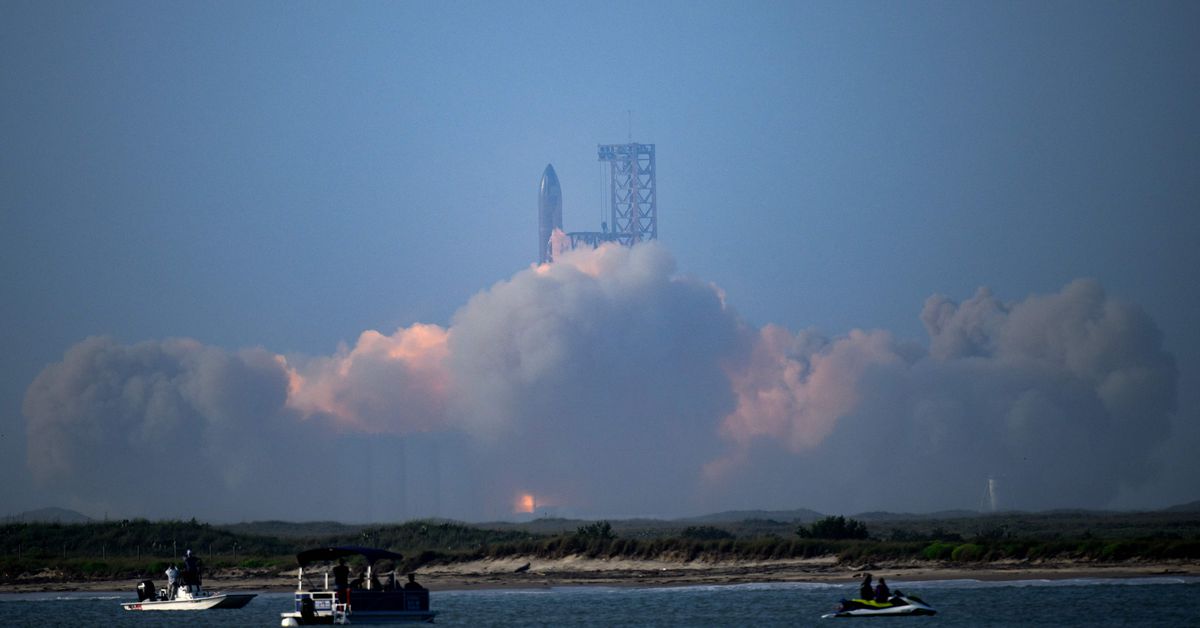
Last week, SpaceX soared into the headlines with the first launch of the world’s most powerful rocket, the Starship. Standing at nearly 400 feet tall when fully stacked, the enormous rocket lifted majestically off the pad and reached an altitude of around 25 miles around four minutes after liftoff, at which point it exploded dramatically.
The test flight has generally been hailed as a success despite the explosion, as the rocket made it into the air. It certainly was an impressive sight to behold. But subsequent photos of the launch pad at the Starbase facility in Boca Chica, Texas, show significant damage, far beyond what had been expected.
In addition to damage to the launch pad, which could potentially have contributed to the failure of some of the rocket’s engines, nearby residents and environmental activists have complained of environmental damage to the surrounding area. The Starship is now grounded until the Federal Aviation Administration (FAA) can perform an investigation into the incident.
The launch caused significant damage, far beyond what had been expected
The failure of the launch pad was “catastrophic,” according to Phil Metzger, a planetary scientist at the University of Central Florida who has worked on launch pad research for NASA. Images from the facility taken after the launch show blackened structures, chunks of concrete missing, and a huge crater in the ground. The destruction of the launch pad generated a large cloud of dust and debris, which spread out from the facility, including some which struck at least one nearby vehicle.
“Launch pads are as complex as rockets are,” Metzger told The Verge. The problem at Boca Chica was that the concrete material that makes up the pad, called Fondag, cracked due to the heat and force of the rocket engines firing. The gasses being expelled from the engines then entered the cracks at a high pressure and fractured them further, eroding the material of the launch pad away.
Photo by Patrick T. Fallon / AFP via Getty Images
Photo by Patrick T. Fallon / AFP via Getty Images
Chunks of material were blown high into the air, with debris striking at least one car near the pad. Although that sounds wild, this appeared to be within the known danger zone of the rocket, called the hazard area, which is an area along the rocket’s planned flight path that is cleared for safety.
So debris striking a car within this area is “not crazy — that’s acceptable,” Metzger said. “You don’t want it to happen, but that’s the reason you have a blast danger zone.” No one was hurt during the launch, and the FAA confirmed it had received no reports of damage to public property.
So debris striking a car within this area is “not crazy — that’s acceptable,” Metzger said
The problem is that the disintegrated launch pad meant that the dirt beneath the concrete was eroded, too, throwing up large quantities of dust, which reportedly spread over several miles from the launch site. This dust can be a serious concern for nearby communities as it could potentially be harmful to human health and to the local environment.
To address this issue, SpaceX CEO Elon Musk stated that the team had previously discussed using a water-cooled steel plate to spread heat from the launch across the pad and prevent erosion of the concrete. By creating channels in a steel plate and pushing water through them, the heat from the engines could be spread out.
“In principle, that should be able to keep the steel from melting,” Metzger said.
The steel plate wasn’t ready for the launch, however, so SpaceX decided to go ahead without it. The engineers had assumed, based on a previous static fire test with the Starship engines at 50 percent of capacity, that the concrete pad would survive at least one launch. This miscalculation on SpaceX’s part has been criticized, with commentators speculating that Starship was pushed to test flight (for funsies) before the launch pad was ready.
The company will now install a steel plate at the pad before trying for another launch within the next month or two, according to Musk. SpaceX did not respond to a request for comment, but in a statement posted to its website shortly after the launch, the company said, “With a test like this, success comes from what we learn, and we learned a tremendous amount about the vehicle and ground systems today that will help us improve on future flights of Starship.”
The next flight of the Starship may take longer than Musk’s optimistically stated timeline, however, as the Starship will not be able to fly again until the FAA completes a mishap investigation regarding the launch.
“SpaceX must request a modification to its license to conduct additional launches. The FAA evaluates requests for modification against the regulations to ensure the safety of the public,” the FAA said in a statement to The Verge. “A return to flight of the Starship / Super Heavy vehicle is based on the FAA determining that any system, process, or procedure related to the mishap does not affect public safety.”
Starship will not be able to fly again until the FAA completes a mishap investigation
As well as safety concerns, the destruction of the launch pad could potentially have contributed to a further issue with the launch: between five and eight of the 33 Raptor engines appeared not to be firing at various points during the rocket’s ascent. It is not currently known what caused these engines to fail, but one possibility is that material from the destruction of the launch pad, called ejecta, could have damaged them.
“We always worry about ejecta hitting the rocket nozzles because that’s the most sensitive exposed part of the rocket,” Metzger said. “If you got an unlucky debris strike on a nozzle, we believe it could cause catastrophic loss of the entire engine.” He emphasized that we do not know that this is what happened to the Starship engines as they could have failed for another reason, especially given that the Raptor engines are relatively new and untested.
If ejecta does take out an engine, that can be extremely serious, as one blown engine can lead to a chain reaction in which other nearby engines can blow up, too. When rockets blow up immediately after liftoff, they can cause significant destruction on the ground. In these terms, SpaceX was fortunate that the Starship made it high into the air before exploding. “To be honest, I think it could have been a lot worse than it was,” Metzger said.
“To be honest, I think it could have been a lot worse than it was,” Metzger said
Risk is an inherent part of space development, and SpaceX tempered expectations before the test flight by stating that just making it off the ground would be considered a win. That approach was tacitly endorsed by prominent space figures like NASA Administrator Bill Nelson, who said in a statement following the launch that “Every great achievement throughout history has demanded some level of calculated risk, because with great risk comes great reward.”
However, the issue of the launch pad degrading to such a degree that dirt from beneath the concrete was blown into the air is a significant and unanticipated one. The effects of the launch were felt in the surrounding area, with residents in the nearby town of Port Isabel reportedly complaining of broken windows and shaken buildings as well as dust raining down on their town.
Particulate matter can cause respiratory issues and other health problems, which is why standards for the amount of particulate matter allowed in the air are set by the Environmental Protection Agency. Despite the mess caused by the Starship launch, however, a spokesperson for the town of Port Isabel told The New York Times that there was no “immediate concern for people’s health.”
In addition to the impact on humans, environmental experts have raised concerns reported by CNBC about the effects that both the debris and the noise caused by the launch could have on local wildlife populations.
SpaceX’s high tolerance of risk is what has enabled the company to make such impressive strides forward in areas like reusable rockets, though its move-fast approach has brought it into conflict with safety-oriented bodies like the FAA numerous times in the past. While the decision to test the Starship quickly was a business decision and seemingly a sound one based on the success of getting the rocket off the ground, the impact of the test on the wider environment still needs to be considered.
“If they want to blow up their rocket, that’s their business,” Metzger said. “As long as they’re not hurting anybody or hurting the environment.”







